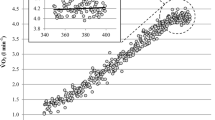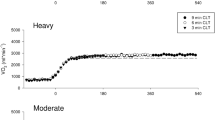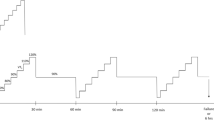Abstract
This study tested the hypothesis that maximum O2 uptake (V̇O2max) sets the uppermost limit to O2 flow. If this is so, the V̇O2 increase with time during high intensity prolonged exercises (slow component) cannot reach V̇O2 levels higher than V̇O2max. To this aim, on 15 amateur cyclists (age, 24±4 years; mean ± S.E.M.) V̇O2max was measured during graded cycloergometric exercise. On different days, the subjects performed exercises at 80% and 90% of the previously determined V̇O2max up to exhaustion (Ẇ80 and Ẇ90, respectively). Measured variables included time to exhaustion (Tlim), power output, V̇O2, CO2 production (V̇CO2), ventilation (V̇E) and blood lactate concentration ([La]). V̇O2max was 4.05±0.08 L•min-1. At the end of Ẇ80 (Tlim 1649±145 s) and Ẇ90 (Tlim 733±65 s), V̇O2 was 3.77±0.13 and 4.08±0.12 L•min-1 respectively. V̇O2 at the end of Ẇ90 was similar to V̇O2max, while at the end of Ẇ80 it was significantly lower. [La] was increased at the end of prolonged exercises not only with respect to rest, but also compared to values at exercise minute 5, indicating anaerobic lactic metabolism contribution to energy production. Compensation of lactic acidosis led to significant increases in V̇E and V̇CO2 at the end of Ẇ80 and Ẇ90. In conclusion, the present results support the hypothesis that V̇O2max really reflects the individual maximum aerobic power, without being limited by factors intrinsic to the experimental procedures.
Similar content being viewed by others
Author information
Authors and Affiliations
Corresponding author
Rights and permissions
About this article
Cite this article
Esposito, F., Schena, F. & Ferretti, G. Phase III V̇O2 increase does not lead to V̇O2 values higher than V̇O2max during prolonged intense exercises in humans. Sport Sci Health 1, 146–152 (2006). https://doi.org/10.1007/s11332-006-0026-7
Received:
Accepted:
Issue Date:
DOI: https://doi.org/10.1007/s11332-006-0026-7




